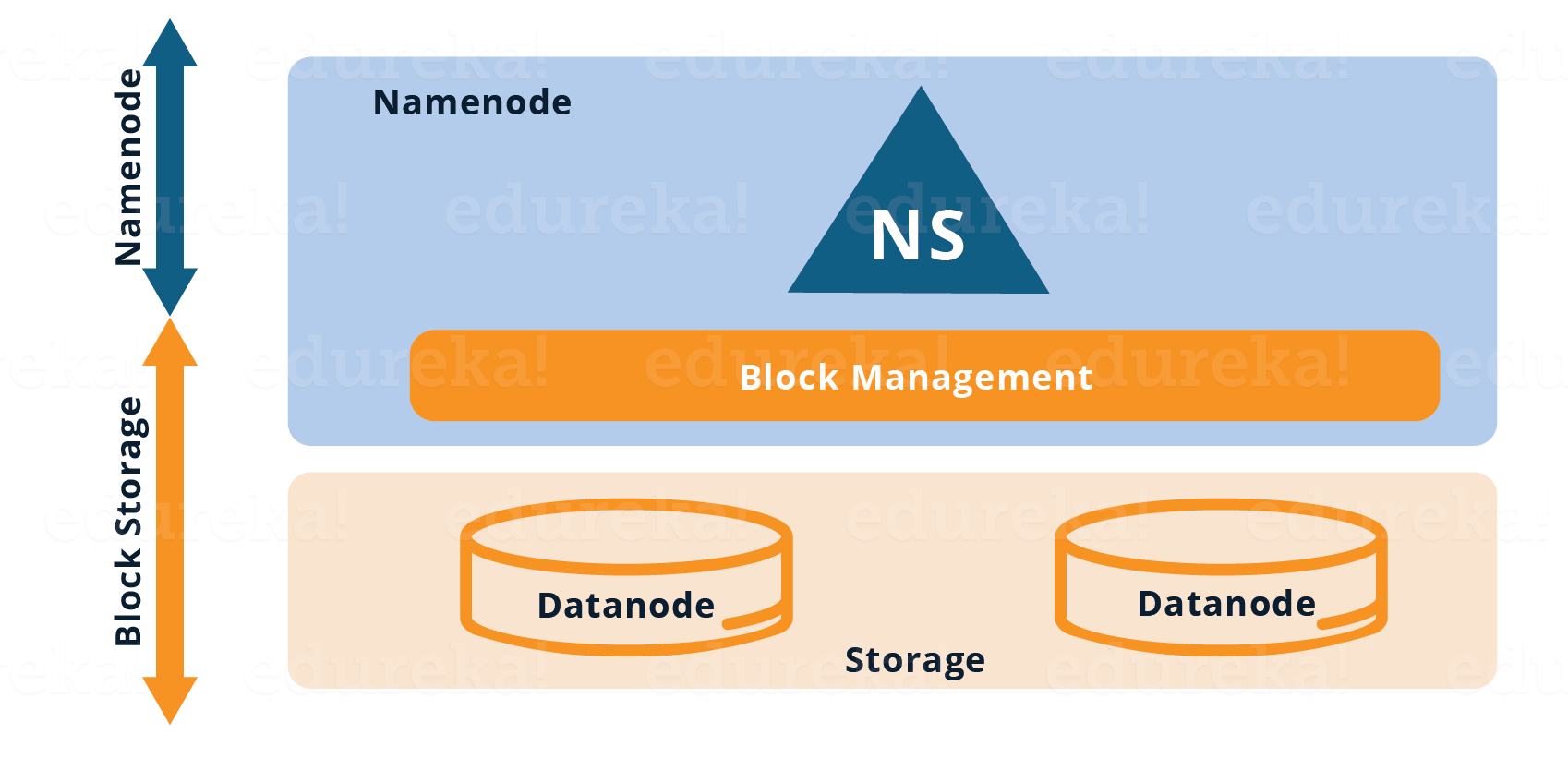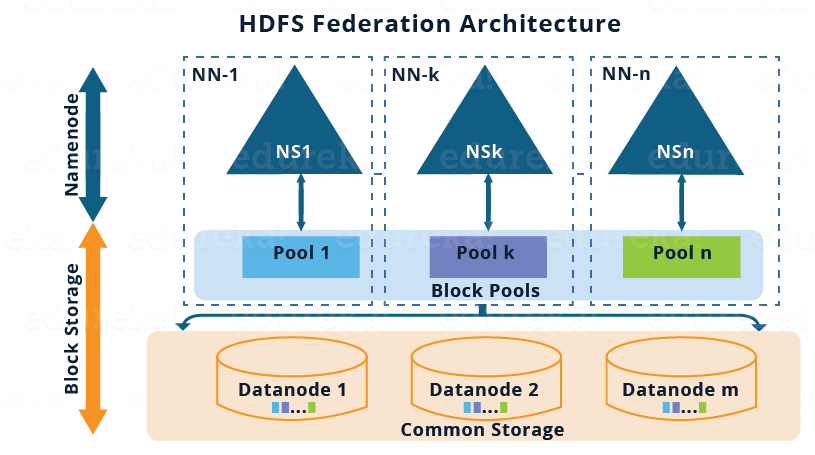Azure Data Engineer Certification (DP-203) Co ...
- 9k Enrolled Learners
- Weekend
- Live Class
In this blog, I will deep dive into Hadoop 2.0 Cluster Architecture Federation. Apache Hadoop has evolved a lot since the release of Apache Hadoop 1.x. As you know from my previous blog that the HDFS Architecture follows Master/Slave Topology where NameNode acts as a master daemon and is responsible for managing other slave nodes called DataNodes. In this ecosystem, this single Master Daemon or NameNode becomes a bottleneck and on the contrary, companies need to have NameNode which is highly available. This very reason became the foundation of HDFS Federation Architecture and HA (High Availability) Architecture.
The topics that I have covered in this blog are as follows:

As you can see in the figure above, the current HDFS has two layers:
2. Physical Storage: It is managed by Data Nodes which are responsible for storing data and thereby provides Read/Write access to the data stored in HDFS.
So, the current HDFS Architecture allows you to have a single namespace for a cluster. In this architecture, a single Name Node is responsible for managing the namespace. This architecture is very convenient and easy to implement. Also, it provides sufficient capability to cater the needs of the small production cluster.
Here this Online Big Data Certification course will explain to you more about HDFS with real-time project experience, which was well designed by Top Industry working Experts.
Find out our Big Data Hadoop Course in Top Cities
As discussed earlier, the current HDFS did suffice to the needs and use cases of a small production cluster. But, big organizations like Yahoo, Facebook found some limitations as the HDFS cluster grew exponentially. Let us have a quick look at some of the limitations:
Master the art of data engineering and revolutionize the way organizations process, store, and analyze data with Data Engineering Certification Program.
The pictorial representation of the HDFS Federation Architecture is given below:

Before moving ahead, let me briefly talk about the above architectural image:
Now, let’s understand the components of the HDFS Federation Architecture in detail:
Block pool is nothing but set of blocks belonging to a specific Namespace. So, we have a collection of block pool where each block pool is managed independently from the other. This independence where each block pool is managed independently allows the namespace to create Block IDs for new blocks without the coordination with other namespaces. The data blocks present in all the block pool are stored in all the DataNodes. Basically, block pool provides an abstraction such that the data blocks residing in the DataNodes (as in the Single Namespace Architecture) can be grouped corresponding to a particular namespace.
Namespace volume is nothing but namespace along with its block pool. Therefore, in HDFS Federation we have multiple namespace volumes. It is a self-contained unit of management, i.e. Each namespace volume can function independently. If a NameNode or namespace is deleted, the corresponding block pool which is residing on the DataNodes will also be deleted.
Now, I guess you have a pretty good idea about HDFS Federation Architecture. It is more of a theoretical concept and people do not use it in a practical production system generally. There are some implementation issues with HDFS Federation that makes it difficult to deploy. Therefore, the HA (High Availability) Architecture is preferred to solve the Single Point of Failure problem. I have covered the HDFS HA Architecture in my next blog.
Now that you have understood Hadoop HDFS Federation Architecture, check out the Big Data training in chennai by Edureka, a trusted online learning company with a network of more than 250,000 satisfied learners spread across the globe. The Edureka Big Data Hadoop Certification Training course helps learners become expert in HDFS, Yarn, MapReduce, Pig, Hive, HBase, Oozie, Flume and Sqoop using real-time use cases on Retail, Social Media, Aviation, Tourism, Finance domain.
Got a question for us? Please mention it in the comments section and we will get back to you.
 REGISTER FOR FREE WEBINAR
REGISTER FOR FREE WEBINAR  Thank you for registering Join Edureka Meetup community for 100+ Free Webinars each month JOIN MEETUP GROUP
Thank you for registering Join Edureka Meetup community for 100+ Free Webinars each month JOIN MEETUP GROUP
edureka.co

I also noticed that in the diagram above in your video you are showing both SecondaryNameNode and StandyNameNode in fact that seems to be incorrect architecture. As Apache Official Hadoop documentation seems to suggest that SecondaryNameNode used to be old concept until HA was not built and was sort of cold standby, now with standy NameNode it is suggested that Secondary NameNode should not exist otherwise it can lead to some errors.
Hey Mukul, thanks for checking out the blog. There is no secondary namenode or standby namenode; these are multple namenodes. Hadoop federation consists of multiple namenodes and they are connected to all datanodes – that is the concept of hadoop federation. Hope this helps. Cheers!
In Hadoop 2.0 there can be multiple namenodes. So what is the control flow when user tries to put file to HDFS ? How does the HDFS client knows which namenode server to contact ?
Looks like no one answered your question.. and its a good one..my guess is that it is the nameservice which keeps track of all the registered namespaces would be first contacted to determine which NameNode is handling which NameSpace and then accordingly it will direct to the proper NameNode.
In Hadoop 2.x, what information do namespace and block pool contain? Please elaborate.
Hi Vinay, in reference to your query, the following link will be of help:
http://hadoop.apache.org/docs/current/hadoop-project-dist/hadoop-hdfs/Federation.html“
Are the Federation and HA concepts still under testing or they are in built features of Hadoop 2.x?
In the federation concept you told that there could be multiple active NameNodes and in HA concept you told that there could only one Active NameNode and Stand-by Name node becomes active only after first one fails. Now my question is whether Federation and HA could exist simultaneously i.e. are there multiple NameNodes and a stand-by NameNode for each of the active Name node?
Hi Deepak, if we consider a Hadoop2.x cluster with multiple namenodes, out of them only one would be active and all other namenodes of that cluster will act as standby. There will not be a standby namenode for each active namenode.
Hope this helps!!
Hate to do this.. but that is an incorrect answer. When in Federation mode then you have multiple active NameNodes and each active NameNode should be able to have a standby NameNode.